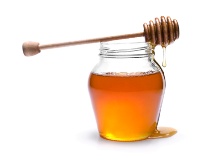 In addition to being tasty, honey also has medicinal and healing properties, according to many studies.
In addition to being tasty, honey also has medicinal and healing properties, according to many studies.
A 2007 study from the National Center for Complementary and Alternative Medicine (NCCAM) found that 38.3% of adults used complementary and alternative medicine, including natural products such as honey.
But it’s not all honey that is beneficial for your health: only raw, unprocessed honey has healing properties.
That’s because honey that has undergone processing loses healthful phytochemicals and propolis, a resin that honey bees collect from tree sap that has properties that protect against virus, bacteria, and fungi, according to the Encyclopedia of Healing Foods.
If you’re suffering from a cough or allergies, you’ve doubtlessly heard that a spoonful of honey in a cup of tea will help alleviate symptoms or eliminate them altogether. It turns out there is truth to that old folk remedy.
It is recommended to keep a jar of raw buckwheat honey handy during cold and flu season. Taking one to two spoonfuls a day has been found to help with symptoms. Or, try adding it to a cup of tea.
Though it has been said that one or two spoonfuls of locally sourced honey can help ease the symptoms of allergies since the bees that make it are drawing pollen from the same plants that are causing symptoms, this is largely unproved and it should also be noted that this it isn’t the same type of pollen that bees use to make honey.
There’s even evidence that raw honey can aid in the healing of burns, wounds, and ulcers as well as easing the pain caused by these conditions. Raw honey has anti-bacterial and anti-septic qualities that help with the healing process. It’s even been used to treat MRSA (antibiotic resistant infections).
In studies, it has been shown that honey appears to draw moisture away from the wound and allows a moist environment and nutrition for tissue growth. Due to its sugar content, honey also prevents microbes, and therefore infections, from infiltrating the afflicted area.
It should be noted that researchers found that using honey, along with traditional wound dressings, is only effective in the treatment of mild to moderate superficial and partial thickness burns. However, using honey as a dressing on chronic ulcers appeared to have no effectiveness.
Be sure to pay close attention to the ingredients of the products you’re buying and make sure that they actually are made with honey and not a substitute. Stick to natural products when possible. They may cost a bit more but at least you can be sure you’re buying something that isn’t artificial and will be effective.
Source(s) for Today’s Article:
“The Use of Complementary and Alternative Medicine in the United States,” National Center for Complementary and Alternative Medicine (NCCAM) web site, 2008; http://nccam.nih.gov/news/camstats/2007/camsurvey_fs1.htm#therapy
Murray, M., Encyclopedia of Healing Foods (New York: Bantam Books, 1988)
“Dr. Oz’s Cold and Rescue Pack”, Dr. Oz web site; http://www.doctoroz.com/videos/dr-oz-cold-flu-rescue-pack
“Can Eating Honey Reduce Seasonal Allergy Symptoms?,” University of Arkansas For Medical Sciences web site, http://www.uamshealth.com/?id=867&sid=1
Knox, A., “Harnessing honey’s healing power,” BBC News web site, June 8, 2004; http://news.bbc.co.uk/1/hi/health/3787867.stm
Wilbert, C., “Honey May Help Heal Wounds,” WebMD web site, October 3, 2008; http://www.webmd.com/skin-problems-and-treatments/news/20081007/honey-may-help-heal-wounds
